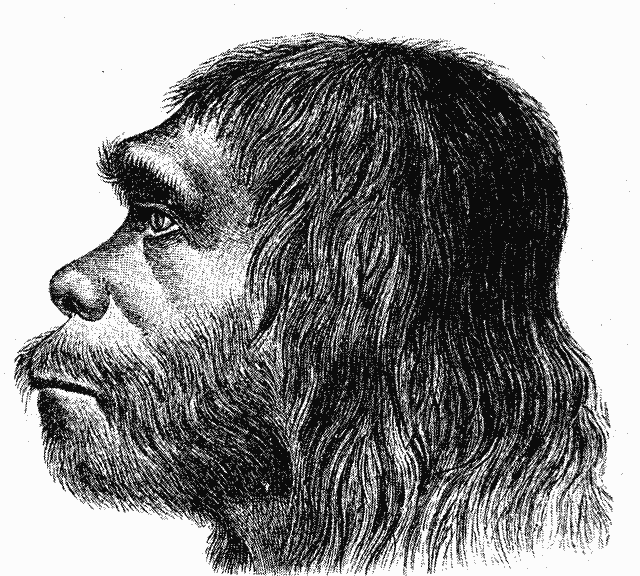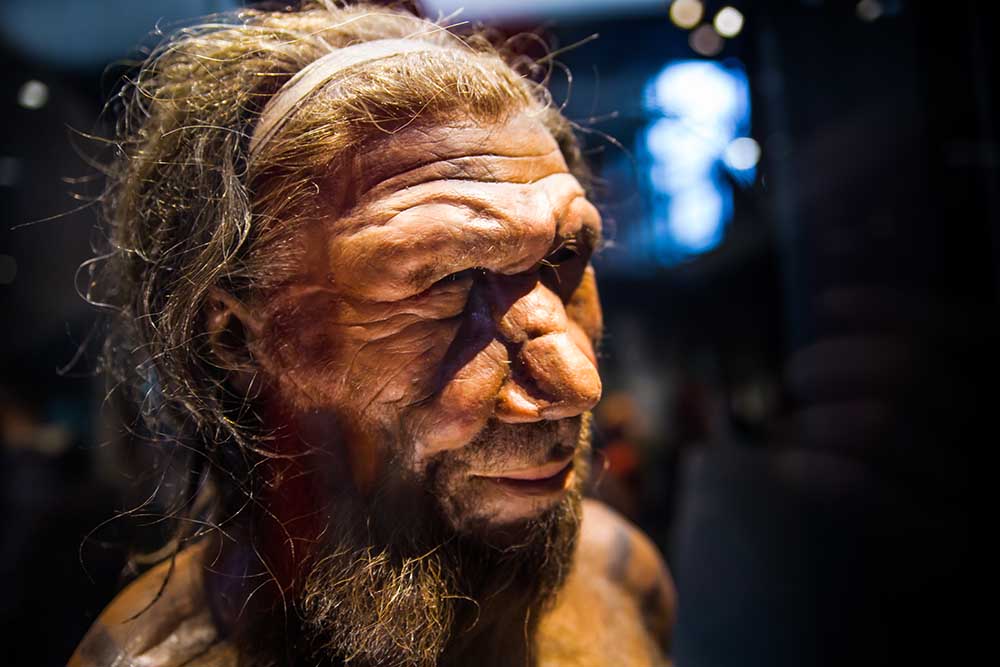Key Points:
- Modern-day humans and neanderthals are of the same genus, but are completely separate species. Evidence suggests that neanderthals did not evolve into humans, but both species evolved from a shared ancestor.
- Both Homo sapiens and neanderthals are bipedal and walk upright. However, bigger brains, greater body mass, and distinct facial features were found in neanderthals.
- Research findings suggest that neanderthals used tools to fabricate clothing and jewelry. Neanderthals may have also practiced cannibalism and been the first to intentionally bury their dead.
- Anthropological evidence from Spain suggests that the earliest neanderthal lived 430,000 years ago, though this is disputed by some.
Where do humans come from? Did we exist thousands of years ago? Millions of years ago? These complicated questions have driven scientific exploration for generations, and many are still unanswered. The field of evolutionary anthropology is dedicated to fitting together the puzzle pieces of the human lineage. Anthropologists use fossil evidence, geological and ecological information, and comparative anatomy to help paint a more complete picture of human history. This article explores how Neanderthals fit into the human evolutionary saga and asks: just how old was the oldest neanderthal?
Common Misconceptions About Neanderthals
Over generations, as humankind has expressed curiosity about its own origins, many theories about the relationship between neanderthals and modern-day humans have emerged. These beliefs have developed and, as new evidence has been brought forth, changed significantly over time.
Outdated notions about neanderthals include the ideas that they were only capable of brutal, savage behavior and that they eventually evolved into today’s human beings. These images have provided entertainment material in various types of media, but the truth according to science is quite different.
How are Neanderthals Related to Modern Humans?

Modern humans-
Homo sapiens©Rawpixel.com/Shutterstock.com
Modern humans are classified as Homo sapiens where “homo” is the genus and “sapien” is the species. The taxonomic classification of Neanderthals is Homo neanderthalensis. This indicates that Neanderthals shared a genus with modern humans, but were a distinctly different species. An analogy to this is how wolves (Canis lupus), coyotes (Canis latrans) and jackals (Canis aureus) are related. They all belong to the same genus and are therefore closely related, but they are separate species.
It is known that Neanderthals did not give rise to modern humans, meaning Neanderthals did not evolve into Homo sapiens. We did, however, at one point share a common ancestor and the exact lineage is still hotly debated. It is also known that modern humans and Neanderthals coexisted before their extinction and the two species are even proven to have interbred. The interbreeding of modern humans and Neanderthals was proven both by fossil evidence as well as DNA evidence. In modern humans, Neanderthal DNA accounts for 2% of genomes of non-African people. This is because Neanderthals evolved outside of Africa.
How are Neanderthals Similar to Modern Humans?

skeleton
©SciePro/Shutterstock.com
Neanderthals are like modern humans in many ways. Two important traits that distinguish hominins (humans and their ancestor) from other apes are bipedalism- meaning the ability to walk on two feet- and larger brains. Both Neanderthals and Homo sapiens exhibited these traits and as a result, had morphological similarities that supported these traits. Both species had a pelvis that was conducive to upright walking and that allowed for birth of an infant with a larger braincase. Based on analysis of fossil cranial fragments, it is predicted that Neanderthals had an average brain size of about 1435 cubic centimeters. With modern human brains averaging 1350 cubic centimeters, Neanderthal brains were larger.
Neanderthals did look very different from modern humans in several way as well. Neanderthals had a generally more robust skeleton and had a body mass about 30% larger than modern humans. This is hypothesized to be a result of inhabiting Europe during the last glacial period. A wide, “barrel-shaped” thorax would reduce the individual’s surface area to volume ratio which would allow for better heat conservation. Unlike modern humans, Neanderthals also had very prominent brow ridges, smaller foreheads, and they lacked chins.
What Do We Know About Neanderthal Behavior?

Neanderthals and humans may have shared many advanced behaviors
©Esteban De Armas/Shutterstock.com
Much has been learned of Neanderthal behavior and culture based on fossil evidence found at sites where they were known to live. There is evidence that Neanderthals processed hides for clothing using both their teeth and fossilized bone “sewing needles”. Also, perforated shells have been found and thought to have been used as jewellery. Different objects ornamented with colored pigmentation are also believed to have served some sort of cultural purpose.
It is speculated that burials were also a unique element in Neanderthal culture. Intentional burials are not seen earlier in the human fossil record, however multiple Neanderthal skeletons have been discovered apparently buried intentionally in the fetal position. It is not known if these burials were symbolic or simply practical.
There is extensive evidence that Neanderthals hunted and used tools. They were successful hunters of large mammals and marine life such as mollusks, crabs, and fish. There is some evidence of cannibalism in Neanderthals. Cut marks on bones at soft tissue attachment sites and percussion marks indicating access to bone marrow suggest meat and marrow was harvested from Neanderthal bones using Neanderthal tools. Neanderthals are associated with Mousterian technology- a particular form of sophisticated stone tools. They are also known to have used fire and construct shelters.
How Old is the Oldest Neanderthal?

Artistic depiction of Homo neanderthalensis based off of fossil morphology
©Hermann Schaaffhausen – Public Domain
The oldest neanderthal lived about 430,000 years ago. This fossil evidence comes from Spain, and is still the subject of debate whether it was a relative of Neanderthals.
In looking at human evolutionary history as a whole, this is incredibly recent. The earliest known hominin species was identified based off a fossil dated to 7,200,000- 6,800,000 years old. This partial cranial fossil belongs to the taxon Sahelanthropus tchadensis and was found in Chad.
Other Neanderthal fossils date to about 250,000 years old. These include cranial fragments found in Italy in 1929 and 1935 at a site called Saccopastore. The holotype specimen- the fossil for which the new species was identified- was discovered in a cave in Germany and was determined to be 40,000 years old. This fossil, Neanderthal 1, was discovered in 1856. Although other Neanderthal fossils had been found before then, it was this fossil that was first recognized as belonging to a new species.
Another significant Neanderthal fossil is known as Shanidar 1. This fossil was discovered in Shanidar, Iraq in 1957 and is between 45,000 and 35,000 years old. This fossil is significant because it is recognized as the first evidence of human compassion. The skull exhibits evidence of a crushing injury above the left eye, the right arm is atrophied, and the right leg is crippled. All of these injuries show signs of healing which indicates that this individual was cared for after likely becoming blind and partially paralyzed. There is no earlier evidence in the human fossil record of potentially fatal injuries being cared for and healed.
Up Next…
Now that you are caught up on what science has to say about the history of neanderthals, explore these other answers to thought-provoking questions.
- How Many Volcanoes Are In The World? – These mountains contain some of the most explosive geological features on the planet! Read to find out how many there are, which countries have the most, and about cities famous for being built on volcanoes.
- Discover Why the Amazon River Used to be a Massive Lake – Did you know that the Amazon River contains eleven times the amount of water in the Mississippi River? Learn where all this water came from and more about the history of the world’s greatest waterway.
- When Did Dinosaurs Go Extinct? – Uncover the answers to why, when, and how dinosaurs disappeared from the earth. And read on to learn about the ones that survived!
Thank you for reading! Have some feedback for us? Contact the AZ Animals editorial team.








